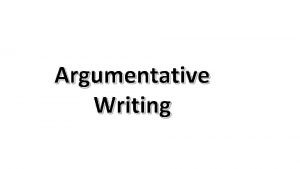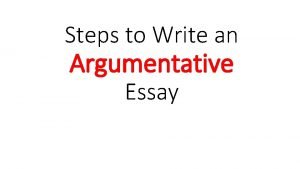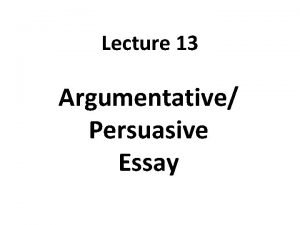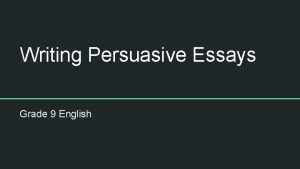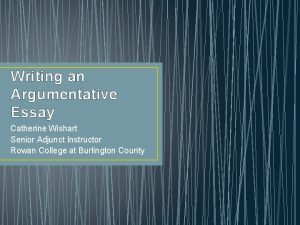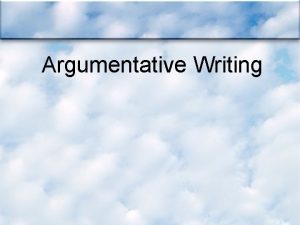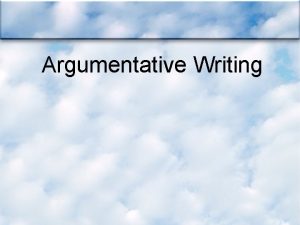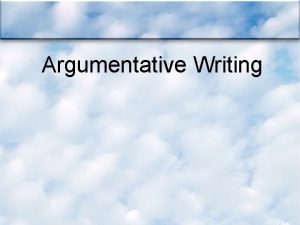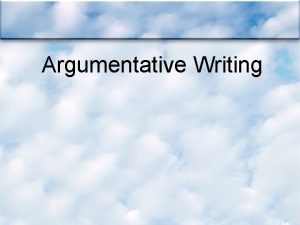Argumentative Writing An Argumentative Essay contains the following








- Slides: 8

Argumentative Writing

An Argumentative Essay contains the following • an introduction • support • a refutation • a conclusion

In the Introduction • background is appropriate. This may consist of a brief history of related past events, a summary of others’ opinions, or a review of the basic facts. • a thesis statement is required. This informs the reader of the writer’s opinion regarding the matter under discussion and previews his plan of development.

In the Body Paragraphs • the writer presents his points of discussion. Each point is typically given its own paragraph and is supported by evidence. Most often, the writer begins with his weakest point and concludes with his stronger arguments. If all the writer’s points are equally strong, he builds a relationship with his audience by discussing the most familiar, less controversial points first.

In the Refutation • the writer acknowledges the opposition. To not do so, may be considered cowardice, stupidity, dishonesty, or weakness. However, acknowledgement does not imply agreement. In this portion of the essay, the writer needs to “refute” or disagree intelligently with the opposition. REMINDERS!!! 1. “Try to think of yourself as engaged not so much in winning over your audience as in courting your audience’s cooperation. ” 2. “Show that you understand genuinely respect your listener’s or reader’s position even if you think the position is ultimately wrong. ”

In the Conclusion • the writer restates, in general terms, the major arguments he has presented in defense of his thesis. • the writer may summarize key points, restate his thesis, reinforce the weakness of his opposition, underscore the logic of his presentation, re-emphasize why this debate is important, suggest a course of action, or challenge the reader to apply the paper’s argument to his own life.

A Checklist : Writing Argumentative Essays ü Does the essay develop an argumentative thesis? ü Has the writer considered the opinions, attitudes, and values of his audience? ü Has the writer identified and refuted opposing arguments? ü Has the writer supported his assertions with evidence? ü Has the writer established his credibility? ü Has the writer been fair? ü Has the writer provided the reader with enough background information? ü Has the writer presented his points clearly and organized them logically? ü Has the writer written an interesting introduction and a strong conclusion? ü Has the writer presented his thoughts in a way that the reader is a “respected partner” rather than a “competitor”? Has he set forth his arguments in the spirit of “mutual support” and “negotiation”? Has he invited “cooperation” rather than “resistance”?

Essay Test Taking Tips • Read the directions carefully. • Make sure the prompt is understood and followed precisely. • Plan the essay before actually writing it. • Budget time wisely. • Be neat. • Don’t write overly long introductions or conclusions. • Focus on one idea per paragraph • If time allows, proofread.


